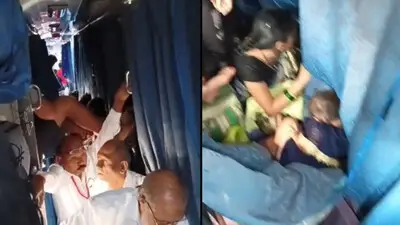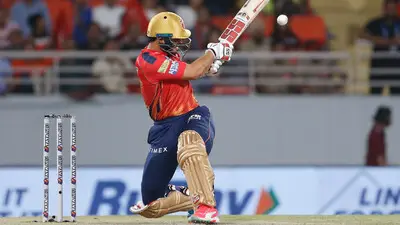Recommended Stories
Marching down from the Raisina Hills to Red Fort, the parade showcased India`s `unity in diversity` and the military might as thousands of spectators along the eight km long route cheered the marching contingents and the mechanised columns.
The well turned out and synchronised military and police contingents led by General Officer Commanding (Delhi) Maj Gen Manvendra Singh marched proudly to the lilting tunes of bands through the Rajpath where President and Supreme Commander of Armed Forces Pratibha Patil took the salute.
The march-past was watched by the Republic Day chief guest Indonesian President Susilo Bambang Yudhoyono, Vice President Hamid Ansari, Prime Minister Manmohan Singh, Defence Minister A K Antony and the country`s top political and military brass.
The capital had turned into a security fortress for the event as unmanned aerial vehicles (UAV) and helicopters scanned the capital from air, snipers kept a hawk-eye vigil from rooftops and armed personnel at "every corner" provided a ground-to-air security apparatus.
Minutes before the parade began, Singh, Antony and chiefs of Army, Navy and Air Force laid wreaths at `Amar Jawan Jyoti`, the British-era World War-I memorial at India Gate, where an eternal flame burns in memory of those who laid down their lives while defending the nation`s frontiers.
The parade began shortly after Patil and her Indonesian counterpart arrived at the Rajpath escorted by the President`s 46 bodyguards riding well-trained and impeccably- bedecked horses.
After the President unfurled the tricolour and a customary 21-gun salute, an Army doctor Major Laishram Jyotin Singh was awarded posthumously the highest peacetime gallantry award -- the Ashok Chakra -- for his bravery while fighting militants during an attack on Indians in Kabul. He was the first Army doctor receiving Ashok Chakra.
Four Mi-17 helicopters then zoomed in from the western skies and showered flower petals on the spectators, signalling the beginning of the parade followed by the winners of the Param Vir Chakra and Ashok Chakra and mounted columns of 61 Cavalry.
The Army showcased its impressive weaponry which included advanced Brahmos Launcher System, T-90 Bheeshma tanks, Brahmos Launcher System, Multi Barrel Rocket System `Pinaka` and Tactical Control Radar `Reporter`.
They also displayed NBC (Nuclear- Biological-Chemical) Reconnaissance Vehicle, indigenous Pontoons Movable Section Bridge, Integrated Network Platform and armoured troop carrier Prahar 510.
Showcasing its air power, Army`s also conducted a flypast of three advanced light helicopters Dhruv in arrowhead formation.
The army contingent from Punjab Regiment, Rajputana Rifles, Rajput Regiment, Sikh Light Infantry, Jammu and Kashmir Light Infantry and Gorkha Rifles marched to the tunes of `Gangotri`, `God of War`, Pragati and `Vir Bharat`.
The next to follow were smartly-dressed 148 Navy personnel and then the Air Force marching to the tunes of Jai Bharati and Sound Barrier. While the Navy showcased aircraft carrier INS Viraat, IAF`s marching contingent showcased the tableaux of Airborne Early Warning and Control System (AWACS) and Aerostat Radar.
The Defence Research and Development Organisation (DRDO) brought the Active Phased Array Radar, which is a shipborne multi-function radar, and Naval Underwater Weapon System at the parade for the first time along with the trainer version of Light Combat Aircraft Tejas.
87-year-old M M Shukla, the flying officer of Royal Air Force based in Rawalpindi during the World War II, who is the oldest participant in this year`s parade, then led the ex-servicemen contingent to a huge applause from the spectators.
Other marching contingents were those of camel-mounted BSF, Assam Rifles, Coast Guard, CRPF, ITBP, CISF, SSB, RPF, Delhi Police, NCC and NSS.
Following the country`s armed and police forces came the country`s rich cultural diversity in full display in 23 tableaux -- 13 from states and ten from ministries. This time, the number of tableaux has risen to 23 from last year`s 21 to provide a kaleidoscopic view of the vibrant cultural heritage.
Rabindranath Tagore, Lord Buddha, Jammu and Kashmir`s Bandh Pandher, Tripura`s Kharchi festival, Punjab`s Mehandi ceremony and Bihar`s Maner Sherif were among the focus areas of tableaux from various states.
The first to be rolled out was the one on `Gurudev` Rabindranath Tagore by Culture Ministry and Sangeet Natak Akademi to commemorate the Nobel laureate`s 150th birth anniversary.
A big bust of Tagore formed the foreground of the tableau with Santiniketan in the backdrop and depiction of a meeting Mahatma Gandhi had with the poet laureate.
His works like Gitanjali and some of his paintings as well as his famous verse `Ekla Chalo Re` (Go Alone) also formed the artwork.
Orissa`s float depicted saint poet Jayadev and 12 chapters Geeta Govindam with paintings on Lord Krishna while Assam`s Ankiya Nat or Bhaona had a scene from Bhagavata Purana on Bhakt Prahlad.
Maharashtra came with the enthralling Lawani dancers on a float modelled on a bullock cart while Tripura gave a glimpse of Kharchi or the worship of earth, a festival on community harmony and integration during which 14 tribal Gods are worshipped to acquire universality.
Gujarat`s offering was the Buddhist heritage in the state and it had a replica of 4th century Buddha statue found in Devni Mori, a stone edict of King Ashoka and Chinese traveller Hiuen Tsang.
A creative representation of two dance forms is what Kerala brought to Delhi by blending the majestic paraphernalia of Kathakali and the simple beauty of Mohiniattom in a "Pakarnattam".
The exotic handicrafts from Bidar -- Bidriware -- was the highlight of Karnataka tableau showcasing the finest of the human workmanship while Punjab came up with the exuberance of mehandi ceremony when the bride is teased and pampered by women-folk.
Bihar`s tableau was the 17th century architectural marvel of Maner Sharif in Patna, the mausoleum of Sufi Saint Makhdoom Daulat.
Guto Cham, an annual ceremony held in monasteries to destroy evil, was the theme of Sikkim`s tableau which depicted the colourful culture of the country`s smallest state while Delhi showcased its harmonious nature through the depiction of a series of religious symbols.
The Bagh prints, one of the most ancient traditions of wooden block printing on clothes, was the theme of Madhya Pradesh`s tableau while Jammu and Kashmir brought Bandh Pandher, a folk theatre, to the parade.
The Ministries and Departments showcased the priority areas and initiatives taken by the government which included saving tigers, emergency response to handle a disaster, new drug development and affordable healthcare and modern farm technologies.
The Central PWD came up with a floral depiction urging people to "Save Tiger, Save Earth" while the Home Ministry displayed its emergency response to handle a chemical disaster and Environment Ministry sought to spread the message of sustainable livelihood.
The Science and Technology Ministry`s tableau -- From Generic to Genome -- depicted the efforts of country`s premier research organisation Council of Scientific and Industrial Research (CSIR) to develop new drugs and ensure affordable health care.
The Agriculture Ministry displayed modern farming techniques which do not compromise with the sustainability factor while the HRD Ministry came up with its showpiece legislation Right to Education through enactment of the atmosphere of a school.
Adopting a healthy lifestyle was the Health Ministry`s theme while the Panchayati Raj Ministry came up with the idea of an active gram sabha for empowered people and accountable panchayats.
Railways also had a tableau on Tagore showcasing a replica of the railway coach used by him during his journey from Bolpur to Kolkata while a group of people danced to the tunes of Rabindra Sangeet.
Following the tableaus, 21 young brave hearts who won the national bravery awards drove through the Rajpath in gypsies to a huge applause following which 686 children enthralled the spectators with a spectacular performance of various dance forms.
Rajasthani folk dance `Rangeela, a performance of `Dahal Thungri` from Assam and Bhangra from Punjab besides an amalgamation of various dance forms drew a good response from the spectators.
A breathtaking dare-devil performance from the Army motorcycle team `Dare Devils` then took the breath of the spectators as they performed back riding, border man salute, lotus formation, human pyramid and ladder balancing.
The spectacular parade ended with a flypast involving three Mi-25 in `Chakra` formation followed by an IL-78, two AN-32 and two Dorniers in Big Boy formation.
Five Jaguars then formed the Arrowhead formation while five MiG-29 formed Fulcrum formation. Three SU-30 MKI later executed Trishul manoeuvre.












